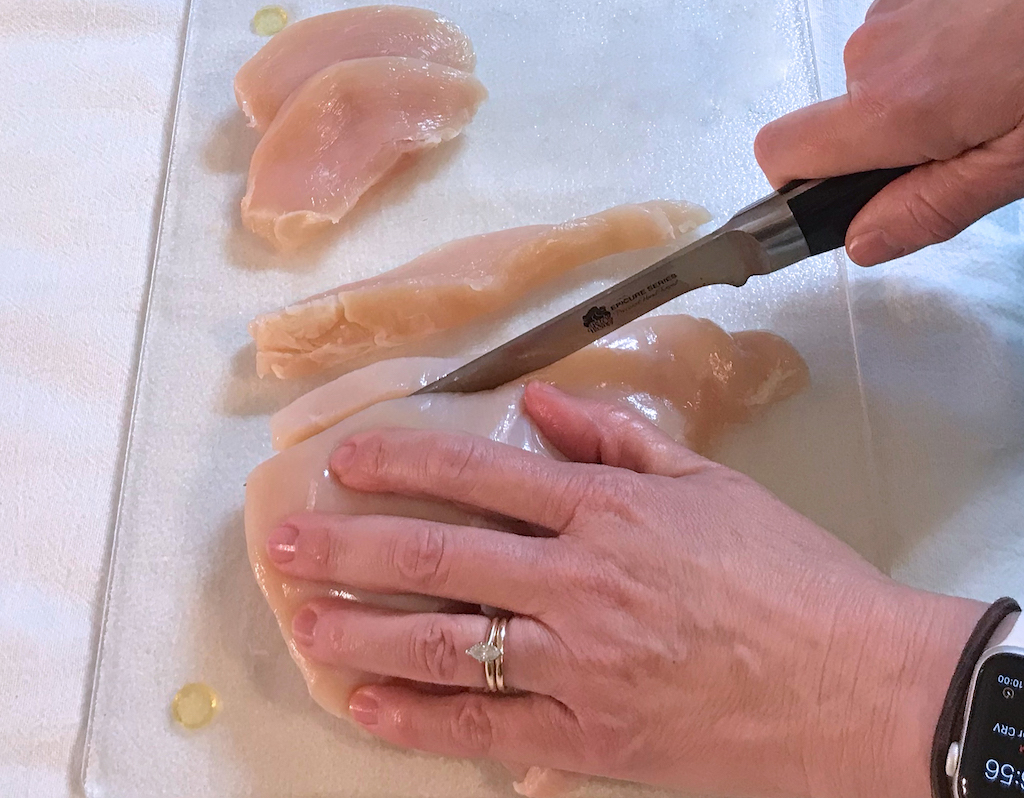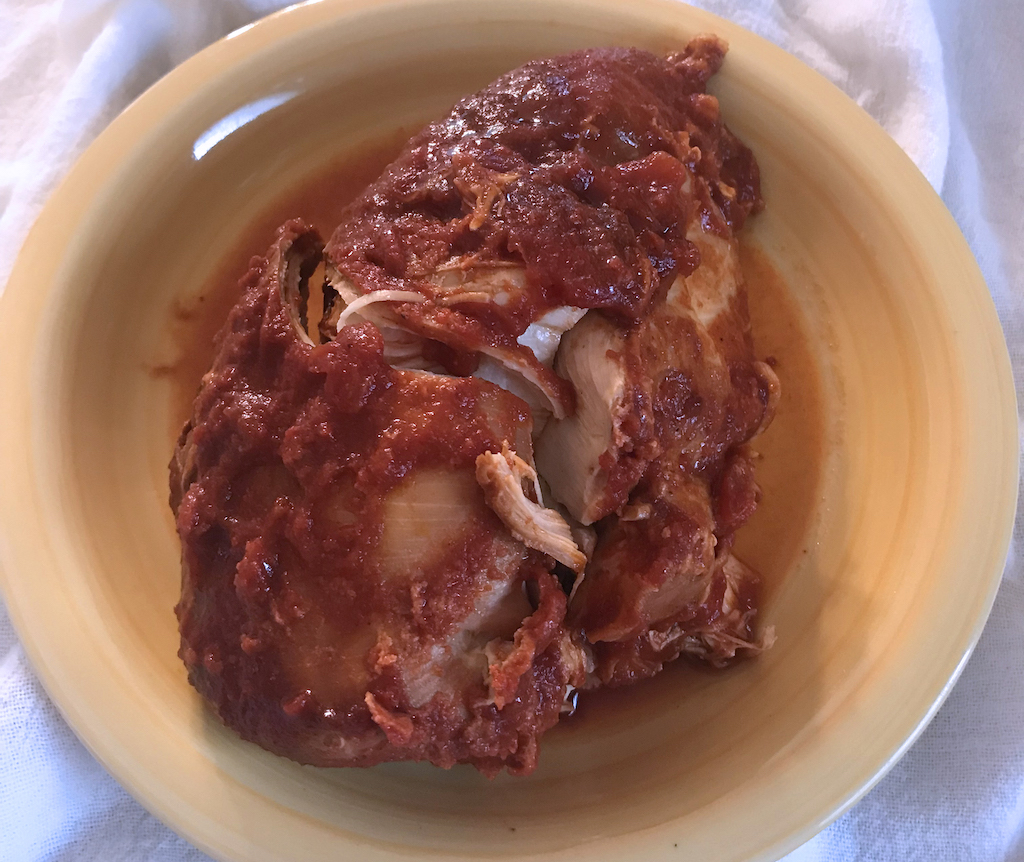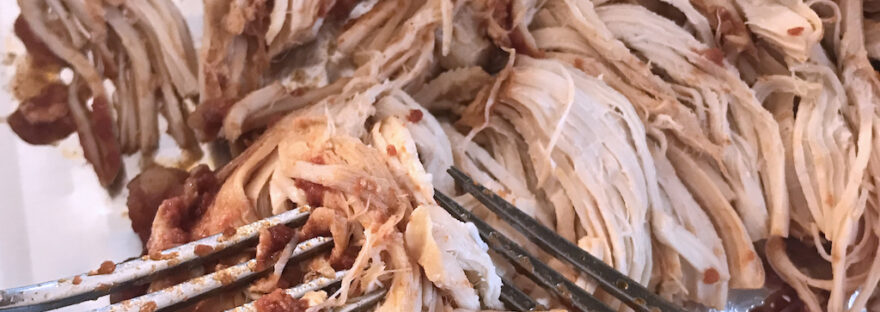I bet you have more recipes for chicken than any other meat. In fact, I bet most folks eat more chicken each and every week than any other meat. It’s so versatile, fairly quick-cooking, isn’t a “trigger” food…I could go on. Many recipes call for the breast meat to be cooked in fillets, strips, or chunks; some even call for it to be shredded or cubed after cooking. Let’s dive into the art of cutting chicken breasts.
Cutting raw chicken is one of my least favorite things. It’s messy, can cause disease if not handled properly, and is so slippery and rubbery, it’s just not much fun to deal with. And I used to really struggle with cooked chicken too, until I learned a few key techniques and found the right knife. Now it’s smooth sailing!
Let’s start with the best knife

For me, that’s this boning knife instead of the fillet knife. The boning knife is a little heavier and more rigid…something you need with chicken…not as much with fish. Of course, these work best when kept sharp. You won’t need to work as hard, particularly on the long cuts.
Cutting raw chicken breasts
Did you know there’s actually a “grain” to a raw chicken breast? There is, and sometimes it’s a lot easier to cut across that grain, not only because of the grain itself, but also because it’s a shorter cut (less chance for that thing to squirm away from you!).

Cutting across the grain is cutting directly across the thickest part of the breast. You end up with small slices. When going for chunks, depending on the size you need, you can easily cut these pieces down.
Cutting with the grain, is cutting a slice from the length of the breast. This is the best option for making chicken strips. It’s a little harder to cut simply because of how wiggly a raw chicken breast can be. Be safe and keep the fingers of your supporting hand out of the way of that knife. You could also make these long cuts, then go across to make your chunks.
And if you’re desperate, freeze your chicken just a little while (set your timer so you don’t forget – maybe 30 minutes to an hour), then it’s firmer and easier to cut.

Cutting cooked chicken breasts
I keep cooked chicken already “processed” (cut up) in the freezer so I can grab it with ease and conserve time on the day I make my recipe. When I find boneless, skinless breasts on sale, I grab a family pack (about 4 pounds) and throw ‘em in the crockpot on low for 7-8 hours (I know mine cooks hot so it usually only takes 7 hours) with about a cup of broth and some good seasoned salt or saltless seasoning blend.


Here’s where it gets fun. If I do this ending at a time when I can go ahead and process my cooked chicken right away, I don’t even need a knife. Slow cooking literally makes that breast fall apart! Using two forks, you can easily press and pull the meat apart in shreds, great for enchiladas, tostadas, in a baked potato, or over salad greens. (For Mexican recipes, I use this Ranchero Chicken recipe rather than the seasoned salt.) I like shredded meat in chicken salad and casseroles as well. I shred mine in its sauce or juices and let the meat soak up anything more it can for moistness.

But some people like chunky chicken for salads or casseroles. To cut the best chunks, you need to let the chicken cool…all the way down and even chill it if you can. Now you can cut across the grain (the short direction) and continue to cut each slice down into whatever size cubes you want. Because the chicken is cold, it will “hang together” in cubes rather than shredding.
Freezing chicken to use later
Of course, you can freeze raw chicken breasts. Buy them at their best price, portion out to freeze (vacuum sealed bags are best for long term freezing), then use ’em when you need ’em.
You can also freeze cooked chicken, already cut or shredded and measured in amounts to use for casseroles or salads (3 cups is standard for 1 pound of chicken). Freeze flat for faster defrosting, and you’re ready to go quickly for later cooking or cold salad.
But here’s the tricky part. You can freeze meat of any kind ONLY once raw and once cooked. Let’s say I cooked my chicken, froze it and later made a casserole with it. I couldn’t then freeze the casserole leftovers. Just tuck that gem away for your health and safety.
Butterflying the breast
For the really thick chicken breasts, you can butterfly them, making the meat thinner overall and allowing for maximum marinating or basting. Chicken breasts don’t really soak up seasonings or marinades so the more surface you can reach with your seasoning, the better it will taste!

Put the fat, short end of the breast to your right if right-handed. Place your left hand flat over the entire top of the breast (the small tip will be under your left wrist). Keeping the knife flat, cut through the center of the breast, using the knife to basically cut the breast in half horizontally. If butterflying, don’t worry about cutting all the way through both sides…you’ll want a little strip of meat to hold it together.

I use this same technique but cut all the way through in order to make breast fillets for faster grilling (and again, more sauce/spice coverage!). Fillets this thickness cook in 5-7 minutes or so on an indoor grill like a Foreman (not an ad…but I love mine with removable plates!).
The breast is “in your court”
How do you want to use your chicken breasts? Chunks for stir-fry, strips for frying, or maybe shredded for chicken salad? Now you know the way to cut your meat, raw or cooked, for each application. With practice (“practice makes progress”), you too will master the art of cutting chicken breasts.
My favorite cutting method is the slow-cooked shred where I don’t even use a knife…what’s yours? Tell me in the comments below!
Looking for chicken salad recipes? Try the ones in these posts…
- Repurposing my favorite SPICY dip (for Chipotle Ranch Chicken Salad)
- Summer salads help you beat the heat (for links to Ultimate Chicken Salad, Chinese Chicken Salad, and Madras Chicken Salad)


This is a great teaching. So will you come to my house and do this for me!!!!! I seem to be more talented cutting beef.
Ha ha…maybe you could come to my house and do the beef. I really struggle with trying to trim a chuck roast into bite-sized pieces for my favorite soup. But I have found it’s easier to just put it in the crockpot whole and then cut it out later! ; ) Where there’s a will, there’s a way!